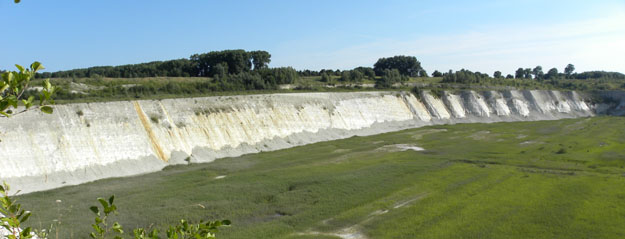
Chalk quarry I visited today near Lägerdorf, Germany. It is Late Cretaceous in age, spanning the Campanian-Maastrichtian stage boundary. Location: N53.90395°, E9.57840°.

Outcrop of the Pierre Shale in South Dakota visited two years ago by a Wooster Geology team. It is also Late Cretaceous and at the Campanian-Maastrichtian stage boundary.
KIEL, GERMANY–Comparing the two very different geological sections pictured above, you should ask how we know that they are precisely the same age. After all, they are thousands of miles apart and are quite different in their composition and fossil content. We can even say that the boundary between the Campanian and Maastrichtian stages (these are fine divisions of geological time) is 70.6 million years old, give or take a hundred thousand years or so. The answer starts with the belemnite fossil Belemnella lanceolata, a nice example of which we found today in the German chalk quarry:
 A belemnite is an extinct cephalopod (a group which includes the modern squid, octopus and others) that is a common fossil in Mesozoic sediments, especially in the Jurassic and Cretaceous Periods. They were swimming predators and so they could live happily in oceanic and shelf waters with little regard for the sediments beneath them. They are thus found in a variety of sedimentary rocks around the world. Belemnella lanceolata is present throughout Europe in a narrow time interval bounded by its origination and extinction. It overlaps in its age range with a variety of other fossils in a chain of co-occurrences that eventually includes Baculites baculus of South Dakota. Because these fossil species evolved and went extinct at specific times, correlation links them together through a particular time interval. Geologists decided that the first appearance of Belemnella lanceolata would be the marker for the base of the Maastrichtian Stage (and by implication the top of the Campanian Stage). Thus we use paleontology and evolution to mark time in the rock record and correlate these time units around the world. For more details on this story you can check out the massive Late Cretaceous correlation chart (a colorful pdf) hosted by Purdue University.
A belemnite is an extinct cephalopod (a group which includes the modern squid, octopus and others) that is a common fossil in Mesozoic sediments, especially in the Jurassic and Cretaceous Periods. They were swimming predators and so they could live happily in oceanic and shelf waters with little regard for the sediments beneath them. They are thus found in a variety of sedimentary rocks around the world. Belemnella lanceolata is present throughout Europe in a narrow time interval bounded by its origination and extinction. It overlaps in its age range with a variety of other fossils in a chain of co-occurrences that eventually includes Baculites baculus of South Dakota. Because these fossil species evolved and went extinct at specific times, correlation links them together through a particular time interval. Geologists decided that the first appearance of Belemnella lanceolata would be the marker for the base of the Maastrichtian Stage (and by implication the top of the Campanian Stage). Thus we use paleontology and evolution to mark time in the rock record and correlate these time units around the world. For more details on this story you can check out the massive Late Cretaceous correlation chart (a colorful pdf) hosted by Purdue University.
How do we know this boundary is 70.6 million years old, more or less? That is another story of volcanic ash falls, igneous rocks, and radioactive dating. Maybe later!



Pingback: Wooster Geologists » Blog Archive » The military advantage of holding the Upper Cretaceous chalk highlands